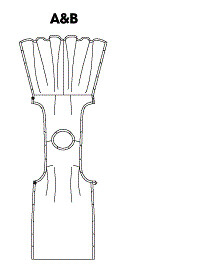Butterick 4790 was my third sewing project ever and the second dress I made, and I was super proud of it at the time. I picked this dress because it looked cute and easy: there are only three pattern pieces, and no zippers, lining or facings to worry about. The pattern itself is very simple and easy to assemble with clear, easy to follow instructions. I used lightweight cotton gingham, in line with my plan for a fun weekend dress and made no pattern alternations.
Two years later, I now know that the pattern, while simple, requires too many alterations to become the cute vintage dress of my dreams.
Butterick 4790, commonly known as the “Walkaway Dress” is described as:
Three pattern pieces, bust darts in front, front and back waist darts, with a back waist seam. Fuller back skirt wraps around to the front panel for a sheath-and-overskirt look.
Apparently B4790 was the highest selling pattern ever, and when it was released in 1952, Butterick dubbed it the “walk-away” dress. It was so easy you could “Start it after breakfast…walk-away in it for luncheon!” The simple yet flattering wrap design and easy construction were what made it so popular. The dress itself is designed as a sheath-style at the front which fastens at the back with snaps, and an overlay circle skirt that loops around and fastens at the waist in front. All of the raw edges are finished with bias binding which is flipped to the outside and treated as a design feature.
The dress goes together easily – all the notches lined up, and it fit the way you would expect from the illustration on the pattern envelope.
The Three Months
I, like many others in the sewing community, fell in love with the retro shape and the claims that it would be super-fast and easy to sew.
Oh, how wrong I was on both counts. Let me step though my issues:
1. This dress is not made for hips. I have what I like to refer to as childbearing hips. Or, in less polite terms, big hips. Normally this means big skirts are perfect, but in this case, the underskirt/front panel was not wide enough to give the level of coverage needed for me to be comfortable with wearing the dress in public.
2. The way that you fasten the dress at the back is not very secure. The pattern calls for you to use snap fastenings to secure the front “underskirt” to the back. Because of how fitted the front sheath piece is, my snaps came unsnapped constantly. I ended up replacing them with hooks and eyes, which were a little more secure but still not ideal.
3. Real life involves wind. Seriously, this thing is not safe for wind – that huge skirt, the not so huge underskirt. Somehow, probably due to the front opening, it lets the wind in so much more than a normal circle skirt. This “vent” and the insufficient overlap between the over and under layers means that even the slightest wind will cause you to desperately try to hold the skirt down.
4. The weight of all that skirt dragged the bodice down at the back, resulting in uneven and awkward hems, where the front underskirt portion is much shorter than the back, like an unintentional hi-low hem.
5. All that bias binding. The pattern instructs you to finish all of the raw edges except the hem with bias binding. In most versions, including the pattern envelope, the binding sits on the outside of the dress, rather than the inside as usual. I don’t think there’s anything wrong with homemade clothes, but that stuff looks “Becky Home-Ecky” in the worst way.
6. The pattern is actually just really unflattering out of the envelope. I think that some of the changes made when the pattern was modernised and re-issued are to blame.
It is, of course totally possible to make a cute version of Butterick 4790: the Edelweiss Patterns blog has some great instructions on how to make the pattern both more vintage-appropriate and flattering. Unfortunately, it was too late for my version, which I realised was unflattering, uncomfortable and unsalvageable.
Personally, I’m just going to chalk this one up to poor judgment – I already binned the finished product after wearing it fewer than 10 times and realising how much it didn’t work for me. I’m not sure what I could have done differently at the time to make it work better. However, with the experience I now have in sewing, I realise that this pattern is not flattering on anyone without a substantial amount of work, which I don’t think is worth it when there are so many other patterns available


It’s too bad that this dress is kind of a turd. The construction is super interesting and the drawings make it look like it could be super flattering.
LikeLike
It’s painful when the sewing visions do not happen the way we want! Thanks for saving me the pain by sharing your comments!
LikeLike
I’m sorry but I love this pattern and have made it many times over. I made button holes for the back underskirt and wear a straight petticoat underneath. I am constantly stopped by people to say what a beautiful dress. The problem you had with dipping hem is more to do with bias cut, normally you would hang for a few days before hemming
LikeLiked by 1 person